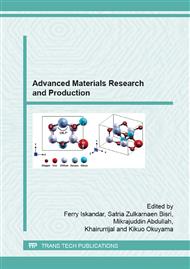p.485
p.489
p.493
p.497
p.502
p.506
p.510
p.515
p.519
The Influence of Cooling Rate on Macrosegregation in Bi-Sn Alloy
Abstract:
Macrosegregation occurs in casting the most case is as a result of slow interdendritic flow due to shrinkage geometry, solid deformation or gravity. In some cases could be the result of solid movement in the early stages of solidification[1]. The problem is that the observation of macrosegregation in steel material is not easy because of high temperature condition. This recent work uses low melting temperature material alloy to simulate the actual condition as a model material. Various efforts to prevent macrosegregation are aimed to control liquid flow and movement of solid, one of them is by cooling rate controling. In this experiment the mold is cooled in three types of cooling medias to represent three different cooling conditions in order to observe the influence of cooling rate on macrosegregation during solidification of the alloy. The outer part close to the mold wall and the bottom of casting contains less solute than inner location. This occurs in all cooling conditions but cooling rate can cause the solute in casting distributed differently. At high cooling rate condition, distribution of Bi rich grain is more uniform. It is mean that macrosegregation is reduced. Bi-richer grains accumulate at the bottom of the ingot. It could be caused by those grains settle due to their relative density to surrounding liquid during solidification.
Info:
Periodical:
Pages:
502-505
Citation:
Online since:
July 2015
Authors:
Keywords:
Price:
Сopyright:
© 2015 Trans Tech Publications Ltd. All Rights Reserved
Share:
Citation:


